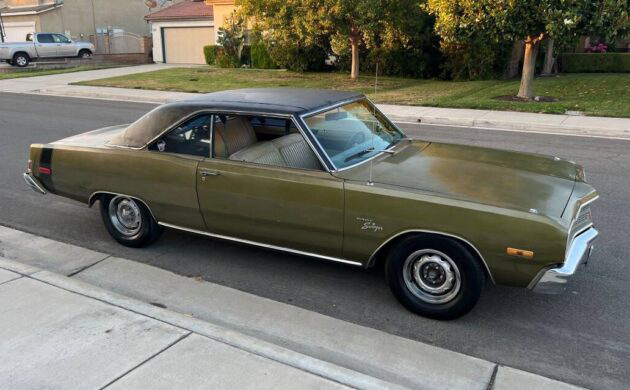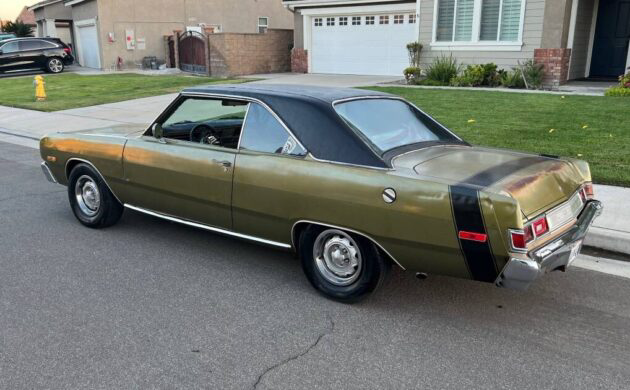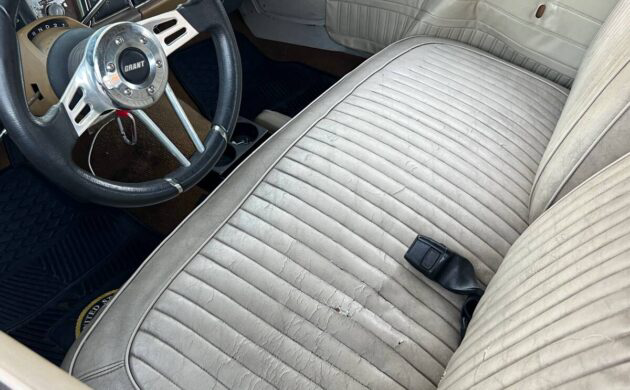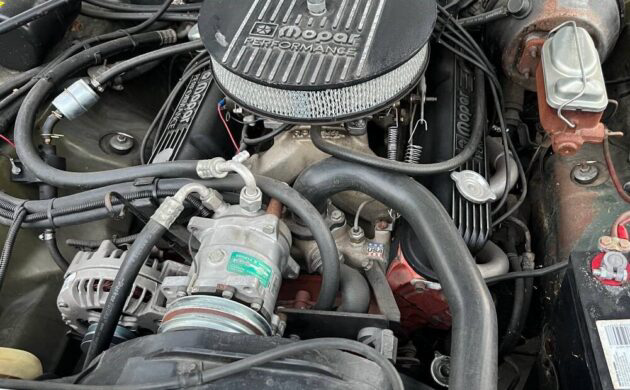Rebuilt 360 V8: 1973 Dodge Dart Swinger
The Dart was a compact car offered by Dodge for most of its life (1963 to 1976). A redesign in 1967 improved its styling and sales. 1969 is when the Dart Swinger 2-door hardtop arrived to attract younger buyers to what was perceived as an economy car. This 1973 Dart Swinger has a rebuilt V8 and automatic transmission and is said to be a reliable ride. Located in Corona, California, this Dodge is available here on craigslist for $7,500 (also $7,800). Thanks for the “swinging” tip, Barn Finder PRA4SNW!
Most 1970s Darts were built with either a 225 cubic inch “Slant-Six” or the 318 small-block V8. But for those who wanted a more spirited performance, buyers could opt for the 340 which was rated at 275 hp. Sources indicate that the last year of the 340 was 1973 but a 360 was already on the scene to fill that void. The seller indicates this car has the 360 instead of the 340, of which the latter was still used in the Dart Sport (rebadged Plymouth Duster).
Usually, the Plymouth Valiant and Dodge Dart had interchangeable body styles, but that was not the case for the Swinger (at least for two years). In 1969-70, there was no “Plymouth Swinger”, but the Scamp came along in 1971, so the playing field was then even. The differences between the 1973 and 1972 Darts (and Swingers) were minimal, though the front bumpers became a little more rigid as federal safety standards were beginning to dictate more low-speed impact protection.
The engine and tranny in this Dodge were rebuilt about four years ago, so the indicated mileage is either since the rebuild (20,000) or the odometer is on its second time around (120,000). This Dart has power steering and brakes, dual exhaust, and maybe factory air conditioning, though the compressor looks to be of a more modern design (and what about the belt?). We’re told this is a powerful, yet reliable little car and it looks to be in fair condition cosmetically. The paint and interior both show signs of wear, but not necessarily to the point of doing a restoration. Does this Dart “swing” your way?
Auctions Ending Soon
 2006 Ford Mustang Saleen S281 SCBid Now3 hours$16,000
2006 Ford Mustang Saleen S281 SCBid Now3 hours$16,000
 2002 Subaru Impreza WRXBid Now3 days$333
2002 Subaru Impreza WRXBid Now3 days$333
 1975 Chevrolet Corvette ConvertibleBid Now3 days$3,000
1975 Chevrolet Corvette ConvertibleBid Now3 days$3,000
 1964 Ford F-100 Camper CustomBid Now3 days$2,000
1964 Ford F-100 Camper CustomBid Now3 days$2,000
 2006 Jeep Wrangler SportBid Now5 days$10,500
2006 Jeep Wrangler SportBid Now5 days$10,500





Comments
Not a bad looking Dart with a nice 360 setup. But seller not given much information about the Dart. Like the what type of rear end. Why does the AC compressor doesn’t have a belt? Also the AC compressor looks like it’s hitting the fan shroud . Need interior help like the right side door panel. No pictures of the back seat or headliner. If everything works good then it’s a fair price to start. This Mopar would a good starter for someone to get into the car hobby. 🐻🇺🇸
I’m probably just not reading correctly the part about “but it was still only available as sedans until 1969”, but why would this be? ’67-’69 were the same (in the sense that a hardtop was available).
Also, the rear bumper treatment was completely different from ’72 to ’73. ’71 and ’72 both have the taillights in the bumper, then in ’73 (for the Dodge), they went to above the bumper as in this example, along with the beak hood.
All the changes with the Darts each year do end up being pretty confusing. I have 2 of them (different years).
Clarification… DUAL taillights in the bumper for ’71-’72. Of course ’70 had single lights in bumper, which carried longer for the Scamp.
And then even I screwed it up. I just realized and came back to say this is a ’74, because it was the 4 in-bumper taillights through ’73!
rear bumper area not accurate for a ’73 Swinger.
This looks like a 1974, because it has the big “Federal” bumpers at both ends of the car. NHTSA required the front bumper to survive a 5 mph impact without damage as an interim step in 1973, the rear bumpers were not enhanced until 1974, when the 5 mph standard was extended to both ends of the car. That’s why the taillights changed, they had to be located above the bumper so the bumper could protect the lights in an impact.
The author needs to check his history books or memory bank. The Dodge Dart, as well as its stablemate the Plymouth Valiant, were available as both a 2dr ht and convertible, as well as sedans. from 63 forward.
You are correct. The 2-door hardtop was offered in 1967-68 but not as a Swinger. Updated.
That’s not a ’73 Swinger…that’s a ’74. The rear end was restyled for 1974 and the Dart kept that styling until the end in 1976. The front end was restyled in 1975. The only change between 1975 and 1976 was the attachment point of the insude rear-view mirror…..in 1975 and before, it was attached to the roof, in 1976, it was attached to the windscreen.
Further, if I recall correctly, the largest engine available in 1974 and beyond for the Dart, Dart Custom, Dart Special Edition and the Swinger was the 318. You could get a 360, but only in the Dart Sport.
Not sure I’d pay $7500 for a car needing bodywork on the quarters (well, at least on the left quarter) and I’d like to know what was under the hood when the car was new. Probably a Slant Six.
What happened to the head rests?
As the EPA emissions rules tightened their grip, horsepower and torque declined with each lowering of the allowable pollution limits. A partial fix was to offer a larger displacement engine to compensate for the loss of power. The problem with this fix was that the bigger engines had lower fuel economy along with the higher power output, and as gas prices exploded during the Arab Oil Embargo of 1973 and again during the Iranian Oil Crisis of 1979, the EPA added Corporate Average Fuel Economy (CAFE) standards to the regulatory soup along with the emissions rules, so simply increasing engine displacement to compensate for declining power output was no longer viable. It soon became obvious that the automakers would have to add new technologies that they previously resisted due to the higher costs to meet the new rules, such as electronic ignition, lockup torque converters, and eventually, electronic fuel injection.
True. When the cost of optional air conditioning was between $300 and $600 list price at the time, that could represent between 10% and 20% of the base price of the car at that time, an expense the very few people, especially people buying economy cars like the Dart, could afford. A/C was most often seen on cars from warm weather states south of the Mason-Dixon Line, where the temperature rarely dropped below freezing, and the car’s occupants spent far more time in the heat than the cold. In those areas, A/C was as necessary to the owners as heat is to someone in the snow belt.
Not a bad looking car from a distance, but I wish there were better pics of the interior. It could be a factory A/C car but the compressor was replaced at some point with an aftermarket one. I’ve never seen one with a 360, it must be quite peppy if it runs good. Most of these rotted away, I hope it finds a good home. He’s asking top dollar and may get lucky if the right Mopar nut sees the ad.